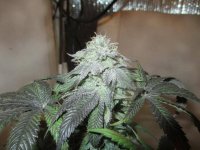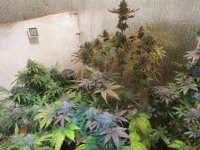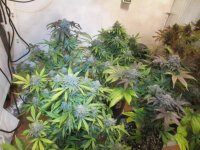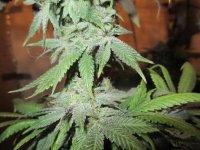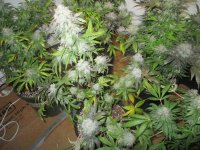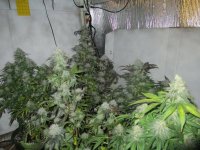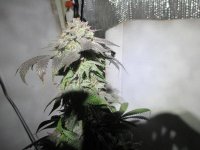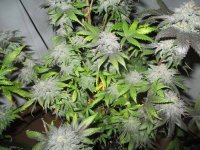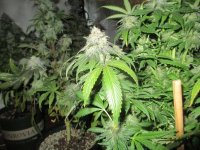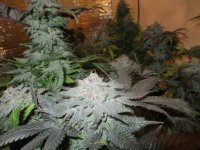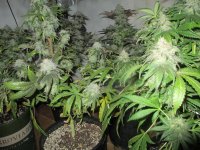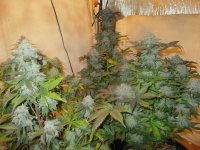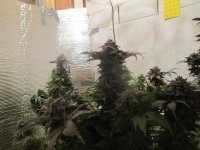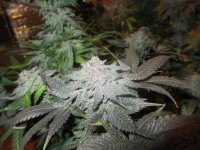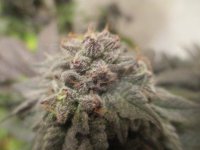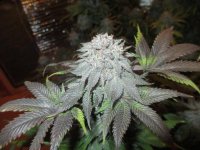-
Happy Birthday ICMag! Been 20 years since Gypsy Nirvana created the forum! We are celebrating with a 4/20 Giveaway and by launching a new Patreon tier called "420club". You can read more here.
-
Important notice: ICMag's T.O.U. has been updated. Please review it here. For your convenience, it is also available in the main forum menu, under 'Quick Links"!
You are using an out of date browser. It may not display this or other websites correctly.
You should upgrade or use an alternative browser.
You should upgrade or use an alternative browser.
creeper's out of the closet
- Thread starter Creeperpark
- Start date
Over-fertilization often results in an unusually high accumulation of salts in the soil, as well as excess nitrogen. While any type of fertilizer can certainly be applied to excess, these two factors cause the bulk of the damage in over-fertilized plants.
Fertilizer selection can affect substrate pH. Fertilizers containing ammonium (NH4+) forms of nitrogen are likely to lower pH, and fertilizers with nitrate (NO3-) are apt to raise pH.
Over fertilization can actually decrease growth and leave plants weak and vulnerable to pests and diseases.
Fertilizer selection can affect substrate pH. Fertilizers containing ammonium (NH4+) forms of nitrogen are likely to lower pH, and fertilizers with nitrate (NO3-) are apt to raise pH.
Over fertilization can actually decrease growth and leave plants weak and vulnerable to pests and diseases.
P
pongster
dayum brother that's sticky and frosty!
well done!!!
that's a lot of grass brother, how do you dry and where?
thanks for sharing
cheers!

well done!!!
that's a lot of grass brother, how do you dry and where?
thanks for sharing
cheers!

Alkalinity and pH are two important factors in determining the suitability of water for irrigating plants. If either one is out of line, nutrient absorption will be limited. If your water pH or alkalinity content is off the mark, your nutrient can be locked out by excess carbonates and bicarbonates.
If your water has high alkalinity (generally considered as ≤150 ppm or 3 meq CaCO3), it has a large buffering capacity that needs to be neutralized before pH can be adjusted.
Use a starting Water with moderate levels of alkalinity (30-60 ppm) to begin as a important source of Ca and Mg. before adding fertilizer.
If your water has high alkalinity (generally considered as ≤150 ppm or 3 meq CaCO3), it has a large buffering capacity that needs to be neutralized before pH can be adjusted.
Use a starting Water with moderate levels of alkalinity (30-60 ppm) to begin as a important source of Ca and Mg. before adding fertilizer.
Cation Exchange Capacity; In order for a plant to absorb nutrients, the nutrients must be dissolved. When nutrients are dissolved, they are in a form called "ions". This simply means that they have electrical charges. If a small percentage of the soil is clay or has Organic matter in it, it is very important for several reasons. Both of these soil fractions have a large number of negative charges on their surface; thus, they attract cation elements and contribute to a higher CEC. At the same time, they also repel anion nutrients ("like" charges). Using this method can result in using less fertilizers by 75 %.
Please know, I'm not trying to tell anyone how to grow, I'm only sharing what's important and helpful to me in my past grows. I spent a lot of time sharing horticulture skills on this thread but putting everything aside, this has to be the most EASY and FASTEST and most FORGIVING way to grow super frosty buds. Total grow time 110 days, running on a low EC Gen Hydro flora series with every watering and a little cal mag. That's It!!
Last important note.
Last important note.
Water matters most of all! Water is polar molecule, having a positive and a negative charge. If I have a lot of unknown stuff in my water, it will give the nutrients no place to link, “making my fertilizer”, less effective. So, only using clean water with a little Cal mag will leave plenty of room for the other important nutrients to be used effectively. Rain, and RO are the only waters I use indoors, but I prefer Rain the most, because of the electron density.
I have switched waters from Rain to RO in a single grow and had big problems from the switch. The Rain had a different electrical charge than the RO, even though they were both about the same ppm or EC, I still had a crash. Each water has a different electrical charge and using a consistent water is very important.
RO water pH will drop to the acidic pH range of 5 – 5.5 when left exposed to the air.
Last important note.
Water matters most of all! Water is polar molecule, having a positive and a negative charge. If I have a lot of unknown stuff in my water, it will give the nutrients no place to link, “making my fertilizer”, less effective. So, only using clean water with a little Cal mag will leave plenty of room for the other important nutrients to be used effectively. Rain, and RO are the only waters I use indoors, but I prefer Rain the most, because of the electron density.
I have switched waters from Rain to RO in a single grow and had big problems from the switch. The Rain had a different electrical charge than the RO, even though they were both about the same ppm or EC, I still had a crash. Each water has a different electrical charge and using a consistent water is very important.
RO water pH will drop to the acidic pH range of 5 – 5.5 when left exposed to the air.

